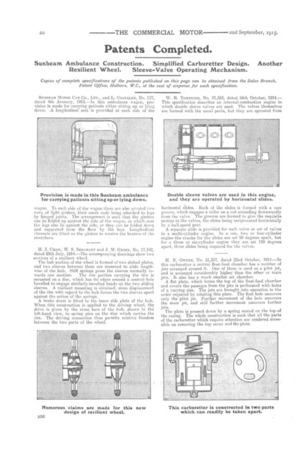Patents Completed.
Page 20

If you've noticed an error in this article please click here to report it so we can fix it.
Sunbeam Ambulance Construction. Simplified Carburetter Design. Another Resilient Wheel. Sleeve-Valve Operating Mechanism.
Copies of complete specifications of the patents published on this page can be obtained from the Sales Branch, Patent Office, Holborn, W.C., at the cost of sixpence for each specification.
SUNBEAM MOTOR CAR CO., LTD., and L. COATALEN, No. 117, dated 4th January, 1915.—In this ambulance wagon, provision is made for carrying patients either sitting up or lying down. A longitudinal seat is provided at each side of the
wagon. To each side of the wagon there are also pivoted two rows of light girders, their outer ends being attached to legs by hinged joints. The arrangement is such that the girders can be folded up against the side of the wagon, in which ease the legs also lie against the side, or they can be folded down and supported from the floor by the legs. Longitudinal channels are fitted on the girders to receive the bearers of the stretchers.
J. effilW, W. S. SERGEANT and J. M. GrtorF, No. 17,142, dated 20th July, 1914.—The accompanying drawings show two sections of a resilient wheel.
The hub portion of the wheel is formed of two dished plates, and two sleeves between them are mounted to slide length. wise of the hub. Stiff• springs press the sleeves normally to wards one another. The rim portion carrying the tire is mounted on a disc, which has its edges around a centrai.hole bevelled to engage similarly-bevelled heath on the two sliding sleeves. A resilient mounting is obtained, since displacement of the rim with regard to the hub forces the two sleeves apart against the action of the springs.
A brake drum is fitted to the inner side plate of the hub. When this construction is applied to the driving wheel, the drive is given by the cross bars of the hub, shown in the left-hand view, to spring pins on the disc which carries the rim. The driving connection thus permits relative freedom between the two parts of the wheel.
W. R. Torn,.wiNs, No. 21,555, dated 26th October, 1l4.— This specification describes an internal-combustion engine in which double sleeve valves are used. The valves themselves are formed with the usual ports, but they are operated from
horizontal slides. Each of the slides is formed with a cam groove, which engages a roller on a rod extending downwardly from the valve. The grooves are formed to give the requisite motion to the valves, the slides being reciprocated horizontally by a half-speed gear.
A separate slide is provided for each valve or set of valves in a multi-cylinder engine. In a one, two or four-cylinder engine the cranks for the slides are set 90 degrees apart, but for a three or six-cylinder engine they are set 120 degrees apart, three slides being required for the valves.
H. N. OwErts, No. 21,347, dated 22nd October, 1914.—In this carburetter a central float-feed-chamber has a number of jets arranged around it. One of those is used as a pilot jet, and is arrang,ed considerably higher than the other or main
jets. It also has a much smaller air chamber. .
A flat plate, which forms the top of the float-feed chamber and covers the passages from the jets is perforated with-holes of a varying size. The jets are brought into operation in the order required by rotating this plate. The first hole uncovers only the pilot jet. Further movement of the hole uncovers the main jet, and still further movement uncovers further jets.
The plate is pressed down by a spring seated on the top of the casing. The whole construction is such that all the parts of the carburetter which require attention are rendered accessible on removing the top cover and the plate.




















